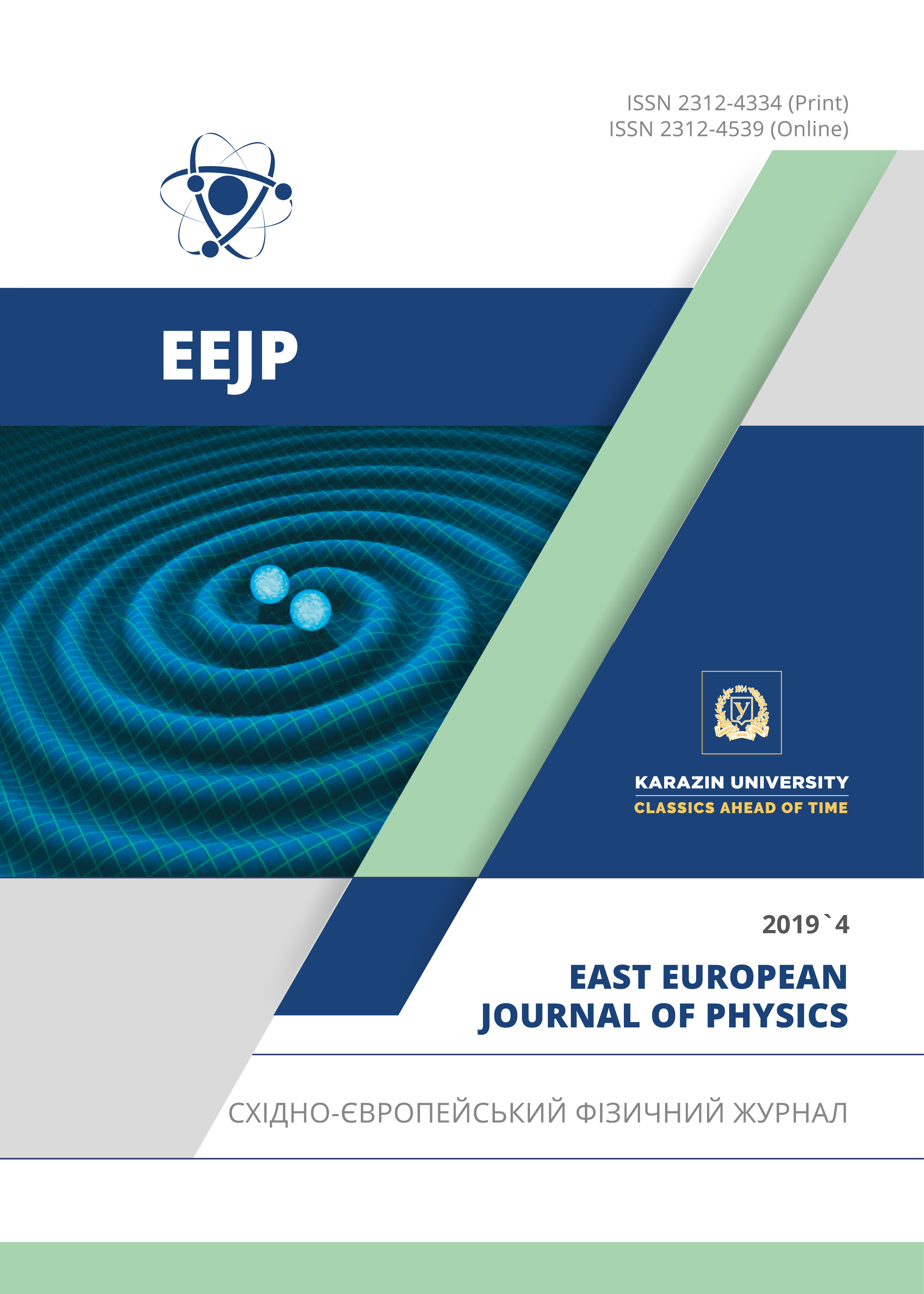Model of Forming Isotropic and Anisotropic Graphite Under High Temperatures and Fluences Neutron Irradiation
Abstract
A model is proposed for describing the shape change of isotropic and anisotropic graphite under the influence of high temperatures and high neutron radiation fluences. The model is based on a new approach, which uses the following provisions: description of the near-pore neighborhood in graphite as a solid solution using the theory of phase transformations of the first kind; consideration of a new phase as a spheroidal pore of small eccentricity, flattened along the direction of greatest stress; taking into account the clustering of carbon atoms at fluences of more than . The graphite non-isotropy is characterized by different pore sizes, different diffusion coefficients, the lengths of the paths of graphite atoms along and across volume of the sample, which in turn depend on the temperature of the sample. It is proposed that the initial element on the basis of which a new phase will be formed is the spheroidal pore of small eccentricity, flattened along the direction of the highest tension. A kinetic equation that describes the diffusion of pores under the influence of high temperatures and intense neutron fluxes is obtained. Initially, the pores are in a field of predetermined stresses oriented along and across the sample. The contribution of diffusion processes is due to the term proportional to the pore distribution function in the sample, and the effect of the neutron flux is described by an additional term in the kinetic equation. The obtained kinetic equation for anisotropic graphite can be transformed for isotropic graphite. For isotropic and anisotropic graphite, model solutions have been obtained that characterize the change in its volume with time under the influence of a neutron flux and high temperature. It is shown that the magnitude of the change in the relative volume of reactor graphite for isotropic graphite exceeds a similar value for anisotropic graphite. Theoretical confirmation of the laws governing the swelling of anisotropic graphites under the influence of large neutron fluences and in the high-temperature field, previously obtained by other authors, is obtained: longitudinal compression of anisotropic graphite samples corresponds to a change in the linear dimensions of isotropic graphites; the transverse compression of anisotropic graphite samples is less than the change in the longitudinal linear dimensions of isotropic graphites.
Downloads
References
M.I. Heggie, I. Suarez-Martinez, C. Davidson and G.H. Buckle, Journal of Nuclear Materials. 413, 150–155 (2011), https://doi.org/10.1016/j.jnucmat.2011.04.015
S.V. Panyukov, A.V. Subbotin and M.V. Arzhakov, Journal of Nuclear Materials. 439, 72–83 (2013), https://doi.org/10.1016/j.jnucmat.2013.03.070
Tim Burchell, (2012), e-print in: http://citeseerx.ist.psu.edu/viewdoc/download?doi=10.1.1.565.2836&rep=rep1&type=pdf
Irradiation Damage in Graphite due to Fast Neutrons in Fission and Fusion Systems, IAEA-TECDOC-1154, (IAEA, Vienna, 2000), pp. 184, retrieved from: http://www-pub.iaea.org/MTCD/Publications/PDF/te_1154_prn.pdf
Gerd Haag, http://juser.fz-juelich.de/record/49235/files/Juel_4183_Haag.pdf
T.D. Burchell and L.L. Snead, Journal of Nuclear Materials. 371, 18–27 (2007), https://doi.org/10.1016/j.jnucmat.2007.05.021
B.J. Marsden, http://www.iaea.org/inis/collection/NCLCollectionStore/_Public/28/008/28008803.pdf
T.D. Burchell, K.I. Murty and J. Eapen, JOM, 62, 93-99 (2010), https://doi.org/10.1007/s11837-010-0145-0.
I.M. Lifshitz and V.V. Slyozov, The kinetics of precipitation from supersaturated solid solutions, J. Phys. Chem. Solids, 19(1 2), 35 (1961), https://doi.org/10.1016/0022-3697(61)90054-3.
V.V. Slezov, Journal of colloid and interface science, 255, 274-292 (2002), https://doi.org/10.1006/jcis.2002.8610.
B.V. Borts, S.F. Skoromnaya and V.I. Tkachenko, The Journal of Kharkiv National University, physical series “Nuclei, Particles, Fields”, 946, 81-89 (2011), http://nuclear.univer.kharkov.ua/lib/946_1(49)_11_p81-89.pdf. (in Russian).
W.J. Gray, Carbon, 11, 383-386 (1973), https://doi.org/10.1016/0008-6223(73)90078-X.
K. Niwase, Philosophical Magazine Letters, 82, 401-408 (2002), https://doi.org/10.1080/09500830210137416.
K. Niwase, Phys. Rev. B, 52, 15785 (1995), https://doi.org/10.1103/PhysRevB.52.15785.
K. Niwase, K. Nakamura, T. Shikama and T. Tanabe, Journal of Nuclear Materials, 170, 106-108 (1990), https://doi.org/10.1016/0022-3115(90)90332-H.
B.A. Gurovich, K.E. Prihod'ko, Problems of atomic science and technology, ser.: Physics of Radiation Effect and Radiation Materials Science, 1(65)-2(66), 156-164 (1997). (in Russian)
B. Rand, P. Bowen, J.F. Knott and B.J. Marsden, in: GTAC Report R39 (2010).
Authors who publish with this journal agree to the following terms:
- Authors retain copyright and grant the journal right of first publication with the work simultaneously licensed under a Creative Commons Attribution License that allows others to share the work with an acknowledgment of the work's authorship and initial publication in this journal.
- Authors are able to enter into separate, additional contractual arrangements for the non-exclusive distribution of the journal's published version of the work (e.g., post it to an institutional repository or publish it in a book), with an acknowledgment of its initial publication in this journal.
- Authors are permitted and encouraged to post their work online (e.g., in institutional repositories or on their website) prior to and during the submission process, as it can lead to productive exchanges, as well as earlier and greater citation of published work (See The Effect of Open Access).








